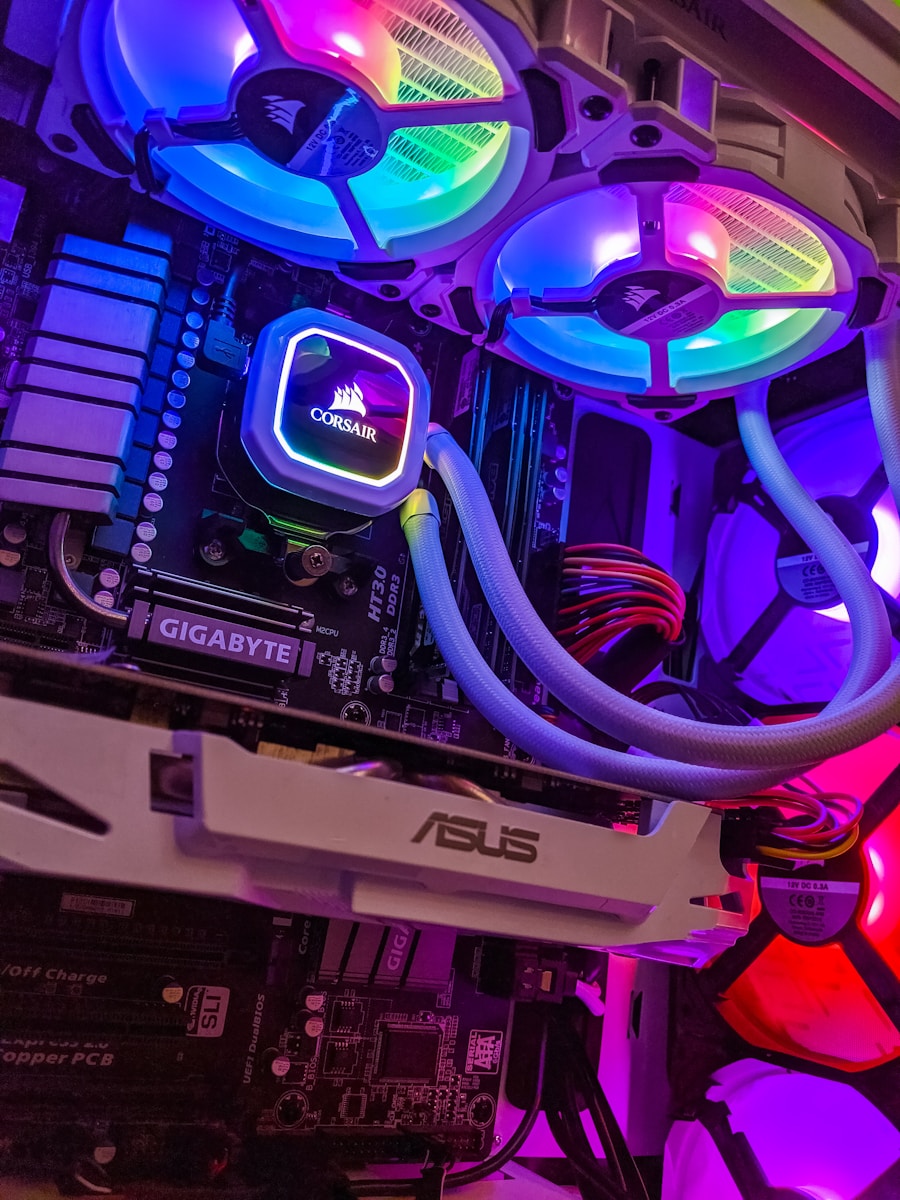In the mood to recreate that retro 80s aesthetic like Scarface, Bladerunner, etc…?
What about creating a contemporary soundtrack/sound design that rivals Dune (2021)?
Well, you’re going to need the best synth plugins you can get your hands on! Today, we’ll be looking at 5 synth plugins that cover the entire spectrum of sounds you’ll need as a film composer/sound designer.
From vintage to modern, there’s something in here for every ear!
But first, let’s start by understanding what types of synths we’ll be working with (and why)…
- The Different Types of Synth Plugins
- 1. Arturia V Collection 8
- 2. Arturia Pigments
- 3. Spectrasonics Omnisphere 2.8
- 4. Reason Studios Reason Rack Plugin
- 5. Output Arcade
- Summary: BEST Synth Plugins for Cinematic, Sound Design, etc…
The Different Types of AU/VST Synth Plugins
Just like the hard synths they emulate, soft synths have different types…
- Modular/Semi-Modular
- Additive
- Subtractive
- Granular
- Wavetable
- Sampler
- Frequency Modulation (FM)
Yup… I’m sure that’s more than you were expecting, right?
So, which type of synth plugin(s) do you need?
Each type of synth plugin has its purpose, but the truth is you don’t need all of them. However, you’ll definitely be much better off with a collection of synth plugins instead of just one.
I’m going to be recommending a few “all-in-one solutions”, you’ll see.
I’ll also be labeling each synth plugin by type so that you know what you’re dealing with!
1. Arturia V Collection 8
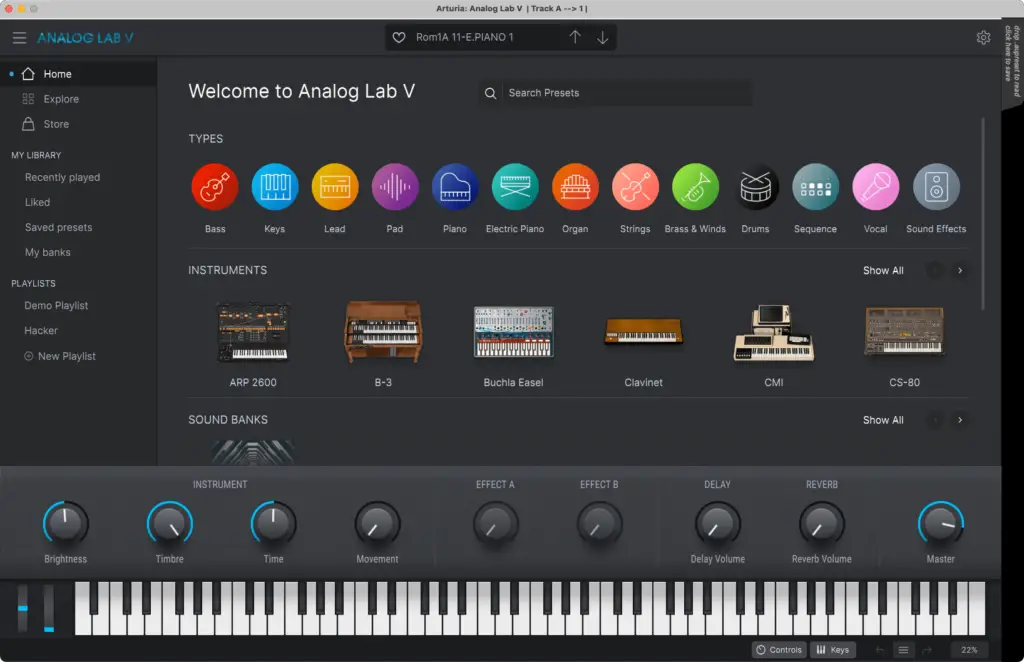
Let’s start with my personal favourite collection of synth plugins!
Arturia V Collection is definitely a revival of the legacy synths and keys that made the 80s/90s sound the way that they did. If you can’t afford the real thing, you’ll be more than satisfied with these synth plugins.
Instead of going into every synth, I’ll simply be talking about the essentials (in my opinion).
If you want more in-depth information about Arturia V Collection 8 though, you can read my product review RIGHT HERE.
1.1. Arturia Mini V3
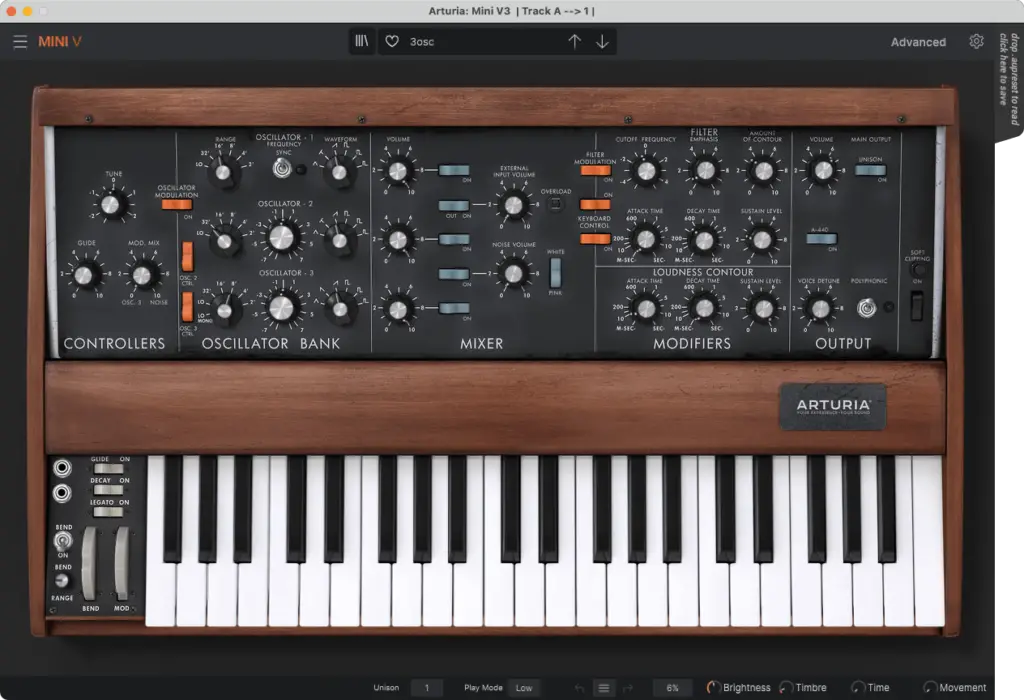
Type: Subtractive (Monophonic) [Analog]
Price: Included (or 149.99$ individually)
Arturia’s Mini V3 is modelled after the Moog Minimoog which means it’s also a monophonic synth.
However, some patches on the Mini V3 are actually polyphonic (thanks to the “polyphonic switch”).
I use it all the time for synth basses and soaring synth leads.
It’s also a great synth plugin for beginners because the interface is relatively simple. You can easily start creating your own sounds but no worries, there are already PLENTY to work with.
1.2. Arturia ARP 2600 V3
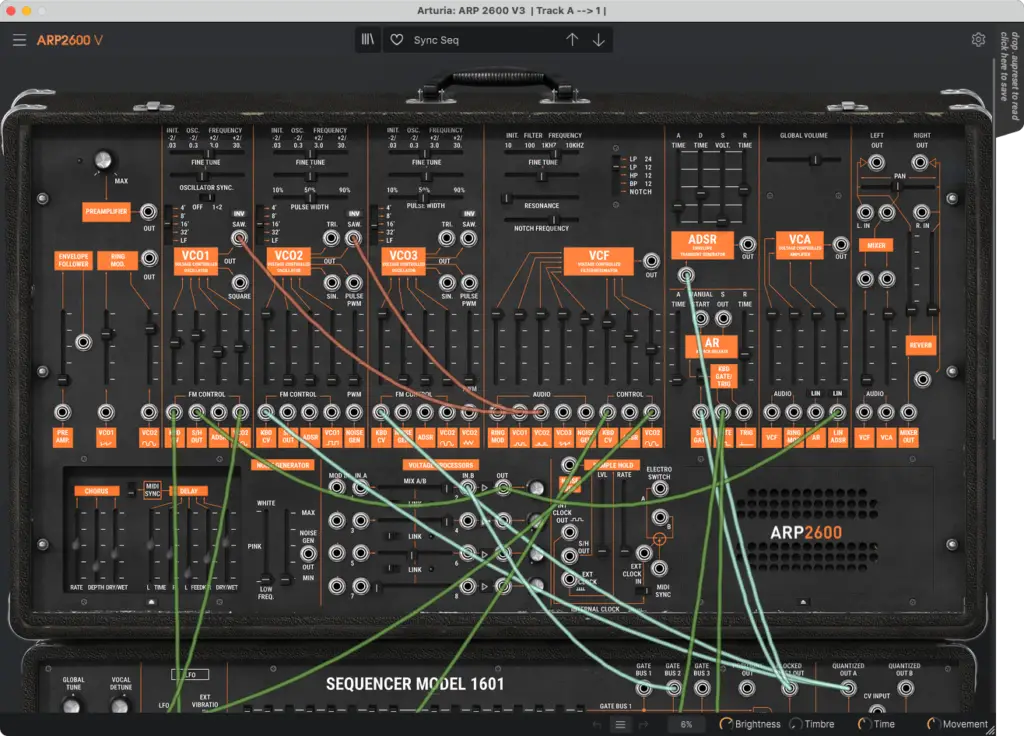
Type: Semi-Modular/Subtractive (Monophonic) [Analog]
Price: Included (or 149.99$ individually)
Arturia’s ARP 2600 V3 is modelled after the ARP 2600.
It’s not as overwhelming as the Moog Modular (which is also in V Collection) so it’s a good synth plugin to introduce yourself to the world of modular synthesis.
It was actually used as a teaching instrument back in the day!
Yes, you can actually connect the cables yourself to/from each module.
What’s really interesting about ARP 2600 V3 is the fact that it has its own built-in sequencer. Although, the original ARP 2600 was monophonic… But this synth plugin can also be polyphonic.
1.3. Arturia Jup-8 V3
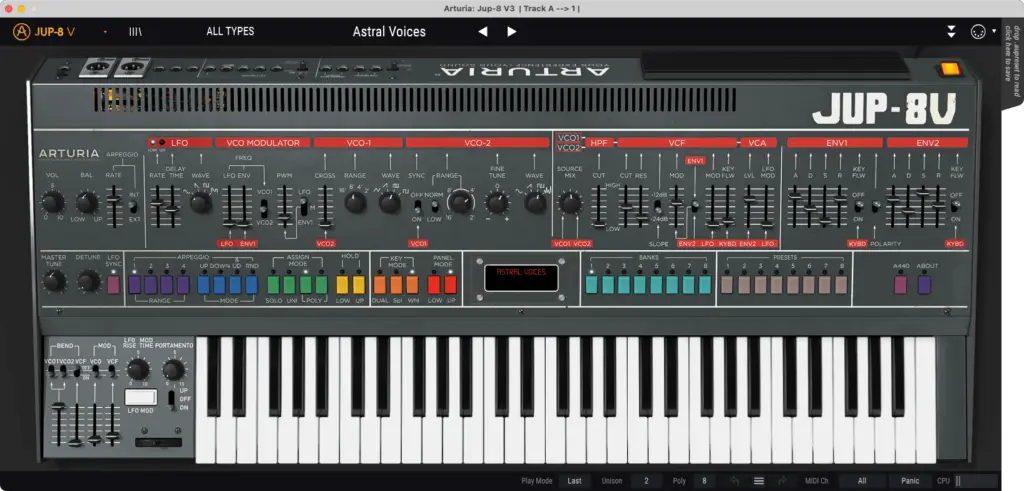
Type: Subtractive (Polyphonic) [Analog]
Price: Included (or 199.99$ individually)
Arturia’s Jup-8 V3 is modelled after one of the first polyphonic synths; the Roland Jupiter-8.
It’s been named the “grandmaster of synth-pop” and with good reason. If you want to nail that 80s aesthetic in your retro soundtracks, then you need this synth plugin!
It’s also a must-have if you’re making retrowave/synthwave.
Probably one of the most interesting features of Jup-8 V3 (and the Jupiter-8) is the ability to split the keyboard into two zones with two different patches.
That makes it a great synth to compose with!
It’s also got a bunch of classic presets from the original Jupiter-8. How nostalgic!
1.4. Arturia CMI V
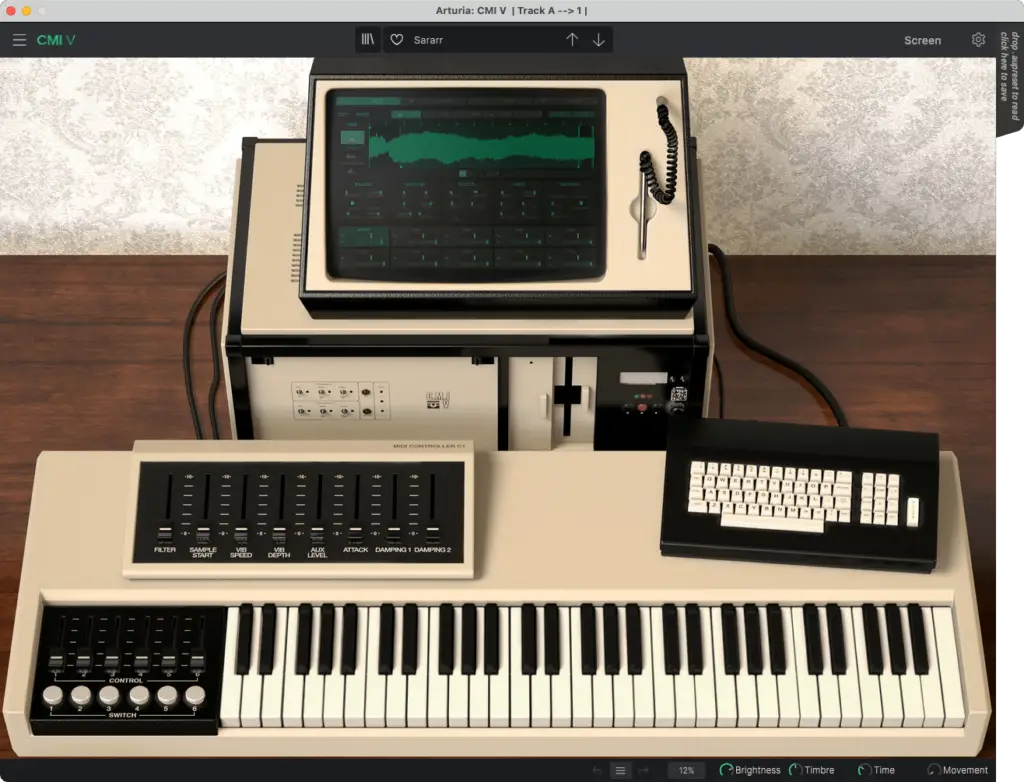
Type: Sampler (Polyphonic) [Digital]
Price: Included (or 149.99$ individually)
When it comes to adding texture to your soundtrack, you can’t go wrong with Arturia’s CMI V.
It’s based on the Fairlight CMI which has been featured in LOTS of soundtracks like Terminator 2, Scarface, Rain Man, etc… Just to name a few!
If you ask me, the CMI is still one of the most advanced musical instruments.
CMI V definitely captures the ingenuity of the original and all of its elegance.
However, you’ll need to be very mindful of how you use the samples in your musical productions. Although CMI V is synchronized to your project’s tempo, different pitches alter the playback speed.
In other words, the sample playback speed gets faster/slower depending on how high/low the pitch is relative to the sample’s original pitch.
That’s why I usually use it for texture and not to compose complex synth parts.
Remember, it’s still a digital sampler at the end of the day!
2. Arturia Pigments 3
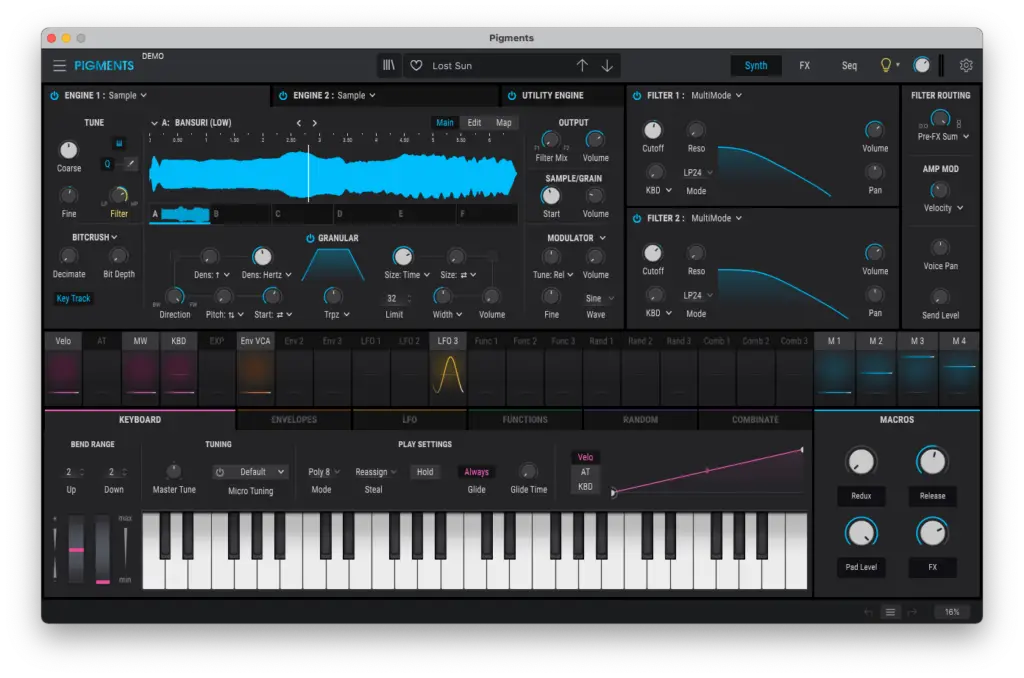
Type: Wavetable, Granular, Modular and Sampler
Price: 199.99$
Relatively new to the market, but definitely worth checking out!
Pigments 3 by Arturia is somewhat of a combination of many different synthesizers (and types of synthesizers). Think of it as the “swiss-army knife” of synth plugins!
Instead of thinking in oscillators with Pigments, we think in terms of “engines”.
You can layer up to 4 different engines.
You can load a different sample into each engine or use the different DSP waveforms available.
However, the real genius of Pigments comes from the intuitive modulation. Just drag-and-drop!
3. Spectrasonics Omnisphere 2.8
Type: Wavetable, Granular, FM and Subtractive
Price: 499.99$
Looking for the ultimate synth for sound design? Look no further!
It’s kind of difficult to place Omnisphere by Spectrasonics into a specific category of synthesis. It truly is a one-of-a-kind instrument that features the ability to layer up to 24 oscillators!
You can even load your own audio files to process them through one of Omnisphere’s engines.
However, you’ll definitely need LOTS of storage space to install this synth plugin (you can install Omnisphere on an external drive though).
It’ll definitely be overwhelming to beginners, but it’s got over 1,400 presets to work from!
For professional sound designers though, Omnisphere is a must-have!
Read more about it HERE.
4. Reason Studios Reason Rack Plugin
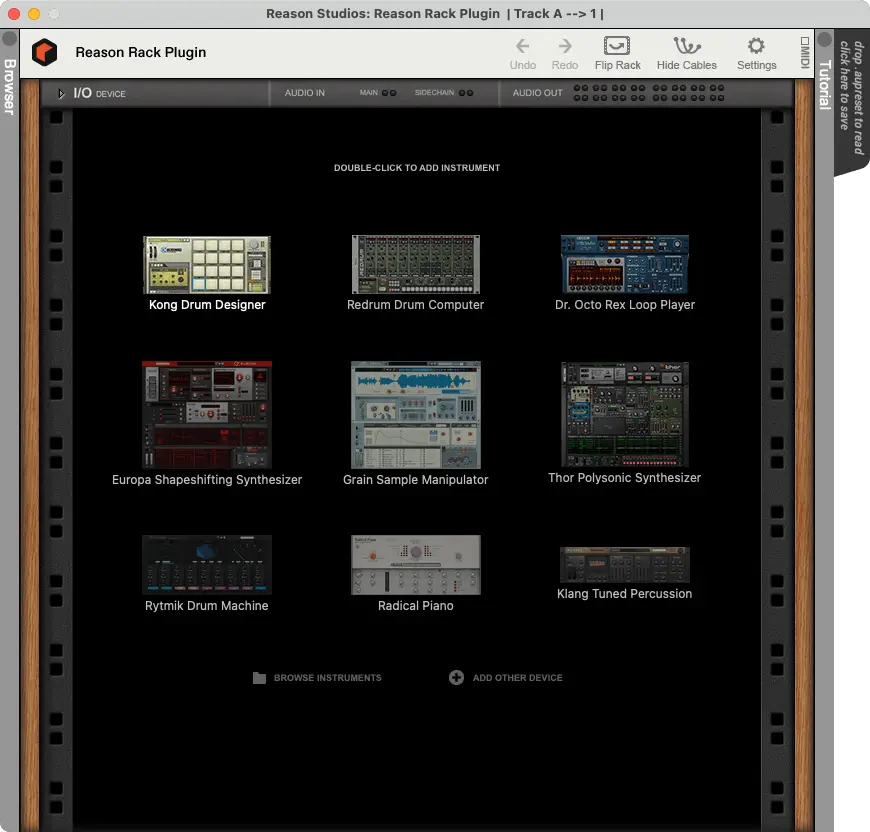
It’s not talked about nearly enough, but the Reason Rack Plugin has some great soft synths.
Actually, the synth plugins in Reason were some of the first soft synths and were used on more records than you can imagine… Read more about it OVER HERE.
I’m just going to be talking about the classics here.
Reason Studios has grown A LOT in the last couple of decades (yes, it’s been around).
I still have difficulty understanding how such a lightweight “virtual rack” can accomplish so much…
The Reason Rack Plugin is the ultimate sound design machine!
4.1. Subtractor Polyphonic Synthesizer

Type: Subtractive (Polyphonic)
Price: Included
Subtractor is probably the most beginner-friendly soft synth you’ll ever use.
It’s the perfect introduction to the world of synthesis and sound design. You have access to 3 oscillators and each one can produce a variety of different waveforms.
However, the Reason Factory Soundbank includes LOTS of presets to get started.
I’d personally use Subtractor for synth basses and synth leads (the perfect substitute for a Minimoog).
4.2. Thor Polysonic Synthesizer
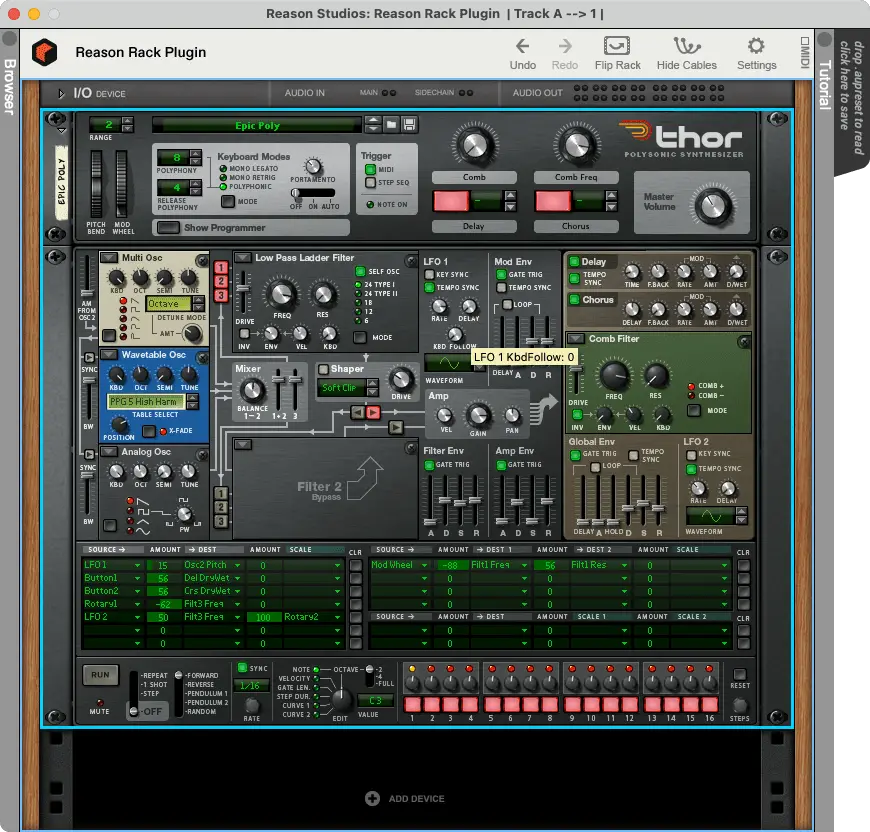
Type: Semi-Modular (Polyphonic)
Price: Included
Slightly more complex, but Thor is definitely a synth plugin you’ll enjoy working with.
If we compare Thor to other modular/semi-modular synth plugins, the user interface is relatively user-friendly and makes it quite easy to visualize what you’re modulating (and with what).
The presets included with the Reason Factory Soundbank are plentiful, but you’ll definitely want to use Thor to start designing your own sounds ASAP.
It’s a great toolbox and the Reason Rack Plugin has plenty else to offer!
4.3. Malstrom Graintable Synthesizer
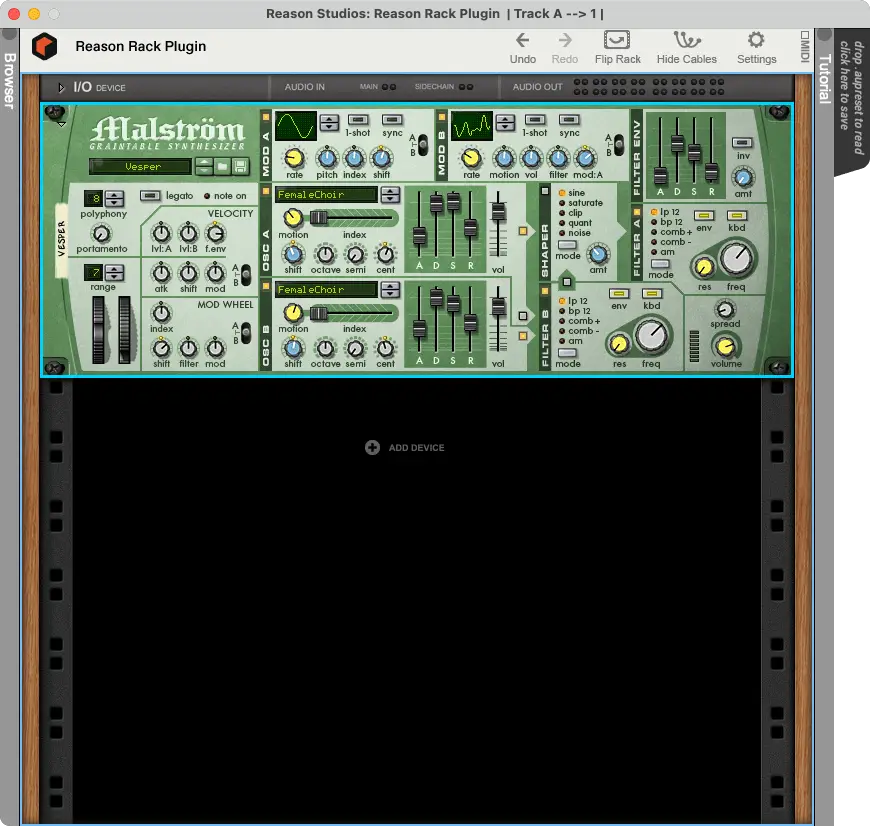
Type: Granular and Wavetable (Polyphonic)
Price: Included
Malstrom is the perfect combination of granular and wavetable synthesis.
If you’re looking for something to fill the gap between Subtractor and Thor, this is the one. You can use it to create much more organic sounds than either.
However, you won’t be capable of loading your own audio samples.
You’ll simply have to learn to work with the samples that are built into it.
Just like the other synth plugins in the Reason Rack Plugin, the UI is beginner-friendly and can be a great learning tool while discovering the ins/outs of sound design.
I’ll admit though… I rarely use Malstrom, but it’s one of the three classic Propellerhead synth plugins!
5. Output Arcade 2.0

Type: Sampler
Price: 9.99$ per month
Arcade 2.0 by Output is best-used to enhance the production value of your current soundtrack.
It’s got some great “Lines” (sample packs) for cinematic music and sound design purposes!
Output is also a subscription-based synth plugin, so it’s super affordable.
However, it’s the ability to manipulate samples using your USB/MIDI controller that makes it such a great tool for composition.
The white keys are used to trigger samples and the black keys are used to modulate them.
Arcade also automatically syncs to your project’s key and tempo.
I just don’t recommend it as an “all-in-one solution” because the possibilities with Arcade are definitely limited to the samples you have access to.
Like I said, it’s great for ornamenting for your musical production.
I use Arcade instead of other royalty-free sample packs/loops. You know where they come from!
Summary: 5 Best AU/VST Synth Plugins for Cinematic, EDM, etc…
I bet you wish you could have all of these synth plugins! Am I right?
I’m sure you’ll have ’em all one day, but if you were going to start with only one… I think you’d get the most “bang for your buck” with Arturia V Collection 8 or the Reason Rack Plugin.
With the Reason Rack Plugin, you also have the option of paying monthly if you go with Reason+.
It’s also possible to pay for V Collection 8 monthly if you finance it (I did that using Splice).
Doesn’t that make things more affordable?
Also, don’t forget that you’re getting much more than just synth plugins with these two!
But I’m curious… Which one of these synth plugins are you going to choose? Let us know in the comments and don’t forget to mention your personal favourites as well!
Thanks for reading, until next time!
Sources
https://www.arturia.com/products/analog-classics/mini-v/overview
https://www.arturia.com/products/analog-classics/arp2600-v/
https://www.arturia.com/products/analog-classics/jup-8-v/overview
https://www.arturia.com/products/analog-classics/cmi-v/overview
https://www.arturia.com/products/analog-classics/pigments/overview
https://www.spectrasonics.net/products/omnisphere/
https://www.reasonstudios.com/en/reason/instruments/subtractor
https://www.reasonstudios.com/en/reason/instruments/thor
https://www.reasonstudios.com/en/reason/instruments/malstrom



